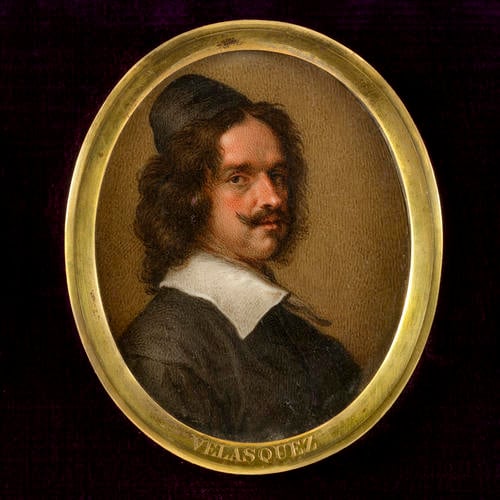-
1 of 253523 objects
Giuseppe Macpherson (1726-c. 1780)
Diego Velasques (1599-1660) c.1772-80
Watercolour on ivory | 7.1 x 5.5 cm (sight) (sight) | RCIN 421142
-
Diego Velasquez (1599-1660) was one of the greatest Spanish painters, known particularly for his skill as a portrait painter. He was born in Seville and apprenticed to Francisco Pacheco. In 1617, he qualified as a master painter and the following year married Pacheco's daughter. In 1622, Velasquez visited Madrid and painted the portrait of the poet Luis de Góngora. The next year he was recalled to paint a portrait of the king, Philip IV, which resulted in his being appointed court painter, and giving him the exclusive right to paint the king's portrait. Velasquez abandoned the genre scenes (images of ordinary life) he had painted earlier in his career, and concentrated almost exclusively on portraiture, although he did occasionally paint historical, mythological and religious pictures. He received a number of prestigious appointments from Philip and was described by the Italian painter Marco Boschini as 'a courtly gentleman of such great dignity as distinguishes any person of authority'. From 1629 to 1631 he visited Italy, and again between 1648 and 1651 to purchase paintings and antiquities for the royal collection. He painted several portraits while in Rome, including that of Pope Innocent X (1650, Rome, Galleria Doria Pamphili). The pope commented that the portrait was troppo vero (too truthful). Back in Madrid, Velasquez acquired further honours and was made a knight of the order of Santiago in 1659. Perhaps his most famous painting is Las Meninas (The Maids of Honour) (c.1656, Madrid, Prado). It shows him painting in his studio, with various members of the royal family and their attendants. Velázquez's prominence in the picture seems to suggest his own importance but, in the background, he has included two pictures by Rubens showing the downfall of mortals who challenge the gods in the arts.
This miniature is one of the collection of copies of 224 self-portraits by artists in the Uffizi Palace, Florence, that Lord Cowper, the art collector and patron, commissioned Giuseppe Macpherson (1726-1780) to paint. He presented the miniatures to King George III in two batches, in 1773 and 1786. Macpherson followed the original self-portraits quite closely, but copied only the head and shoulders. He inscribed the artists' names on the backs of the miniatures – several differ from those in the modern Uffizi catalogue, notably: Bazzi, Bellini, Campi, Annibale Carracci, Gabbiani, Masaccio, Metsys, Moroni, Pencz, Licinio, Schiavone and Spada. None of the miniatures is signed, apart from Macpherson's own self-portrait, which is inscribed: Giuseppe Macpherson / Autore della serie (Giuseppe Macpherson / Author of the series).Macpherson was born in Florence, the son of Donald Macpherson, a footman in the service of Alexander, 2nd Duke of Gordon. He was a pupil of Pompeo Batoni and painted miniatures and enamel portraits in Italy, France and Germany, finally settling in Florence. A James Macpherson is recorded in London and Paris in 1754 but it is not certain that this is the same person. He was described in 1776 as having a special talent for painting on enamel and as being 'almost the only painter in Europe who possesses this art to perfection'. He had a distinguished client list which included some of the crowned heads and dignitaries of Europe. In 1778, he was invited to add his own self-portrait to the famous painters in the grand duke's collection as it 'would do honour to Florence to enrich the collection with a work which shows that we still have some men of true merit' according to Giuseppe Pelli, director of the Uffizi at the time.
Provenance
Presented to George III by Lord Cowper
-
Creator(s)
Acquirer(s)
-
Medium and techniques
Watercolour on ivory
Measurements
7.1 x 5.5 cm (sight) (sight)
Other number(s)
RL 02.5/4
